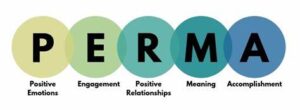How to Savor Positive Emotions and Boost Your Well-Being
Do you want to feel happier, more resilient, and more fulfilled in life? Do you want to build valuable personal resources that can help you achieve your goals and overcome challenges? Do you want to strengthen your relationships with others and express your gratitude more often?
If you answered yes to any of these questions, then this article is for you. We will explore the concept of savoring and how it can help you increase your positive emotions and enhance your well-being. We will also share some practical tips and techniques on how to savor positive emotions in the present, past, and future, as well as with others.
Savoring is an effective way to prolong and amplify positive emotions, which are essential for our well-being and personal growth. Positive emotions can help us cope with stress, broaden our perspective, build our resilience, and foster our creativity. They can also help us connect with others, find meaning in life, and achieve our potential.
However, positive emotions are often fleeting and hard to sustain. We may experience them briefly, but then quickly move on to the next thing or get distracted by negative thoughts or events. We may also take them for granted or fail to appreciate them fully.
That’s where savoring comes in. Savoring is the process of deliberately paying attention to and enhancing positive emotions. It involves noticing, appreciating, and prolonging the good feelings that arise from positive experiences. It also involves sharing them with others or recalling them later.
Savoring is based on the broaden-and-build theory of positive emotions by Barbara Fredrickson, a leading researcher in positive psychology. According to this theory, positive emotions can broaden our awareness and attention, allowing us to see more possibilities and opportunities in our environment. They can also build our personal resources, such as physical, mental, social, and emotional skills and assets that can help us cope with challenges and thrive in life.
By savoring positive emotions, we can extend their duration and intensity, making them more impactful and memorable. We can also create a positive feedback loop that reinforces our happiness and well-being. The more we savor positive emotions, the more we experience them, and the more we benefit from them.
In this article, we will discuss the benefits of savoring positive emotions for our happiness, resilience, mental health, and personal resources. We will also provide some examples and strategies on how to savor positive emotions in different ways: by savoring the present moment, by savoring the past, by savoring the future, and by savoring with others.
By the end of this article, you will have a better understanding of what savoring is and why it matters. You will also have some practical tools and techniques that you can apply in your daily life to savor positive emotions more often and more deeply.
The Broaden-and-Build Theory of Positive Emotions
Before we explore the benefits and techniques of savoring, let’s first understand the underlying mechanism of how positive emotions can enhance our well-being and personal growth. This mechanism is explained by the broaden-and-build theory of positive emotions by Barbara Fredrickson, a leading researcher in positive psychology.
According to this theory, positive emotions have two main effects: they broaden our awareness and attention, and they build our personal resources.
How positive emotions can broaden our awareness and attention
Positive emotions can broaden our awareness and attention, allowing us to see more possibilities and opportunities in our environment. They can also help us to be more open-minded, curious, creative, and flexible in our thinking and behavior.
For example, when we feel joy, we are more likely to explore new things, learn new skills, or try new activities. When we feel love, we are more likely to connect with others, empathize with them, or cooperate with them. When we feel gratitude, we are more likely to appreciate what we have, notice the good things in life, or express our thanks.
By broadening our awareness and attention, positive emotions can help us to discover and experience more positive aspects of our lives, as well as to cope with negative aspects more effectively.
How positive emotions can build our personal resources
Positive emotions can also build our personal resources, which are physical, mental, social, and emotional skills and assets that can help us cope with challenges and thrive in life.
For example, when we feel joy, we can build our physical resources by improving our health and energy. When we feel love, we can build our social resources by strengthening our relationships and support. When we feel gratitude, we can build our emotional resources by enhancing our self-esteem and happiness.
By building our personal resources, positive emotions can help us to achieve our goals and fulfill our potential, as well as to be more resilient and adaptable in the face of difficulties.
In summary, the broaden-and-build theory of positive emotions explains how positive emotions can enhance our well-being and personal growth by broadening our awareness and attention and building our personal resources. By savoring positive emotions, we can enhance both these effects and create a positive feedback loop that reinforces our well-being and personal growth.
Benefits of Savoring
Now that we have a clear understanding of what savoring is and how it works, let’s explore some of the benefits of savoring positive emotions for our well-being and personal growth.
Savoring positive emotions can have many benefits for our happiness, resilience, mental health, and personal resources. Here are some of the main benefits of savoring:
- Enhancing happiness: Savoring can help us increase our happiness and life satisfaction by making us more aware and appreciative of the positive experiences in our lives. It can also help us create more positive memories that we can recall later to boost our mood.
- Building resilience: Savoring can help us build resilience and cope with stress by providing us with positive emotions that can buffer us from negative emotions and events. It can also help us cultivate a positive outlook and optimism that can help us overcome challenges and bounce back from setbacks.
- Improving mental health: Savoring can help us improve our mental health and prevent or reduce symptoms of depression and anxiety by reducing rumination and worry, and increasing self-esteem and self-compassion. It can also help us regulate our emotions and cope with negative emotions more effectively.
- Developing personal resources: Savoring can help us develop valuable personal resources that can help us achieve our goals and thrive in life. These include physical resources, such as health and energy; mental resources, such as knowledge and skills; social resources, such as relationships and support; and emotional resources, such as confidence and motivation.
As you can see, savoring positive emotions can have many positive effects on our well-being and personal growth. By savoring positive emotions more often and more deeply, we can enhance our happiness, resilience, mental health, and personal resources. We can also create a positive feedback loop that reinforces our well-being and personal growth.
In the next section, we will discuss some practical ways to savor positive emotions in different contexts: in the present, past, and future, as well as with others.
Ways to Savor Positive Emotions
Savoring positive emotions can be done in different ways and in different contexts. In this section, we will explore some of the ways to savor positive emotions in the present, past, and future, as well as with others.
Savoring the Present Moment
One of the most common and effective ways to savor positive emotions is to savor the present moment. This involves paying attention to and appreciating the positive aspects of our current experiences, such as sensory details, thoughts, feelings, and actions.
Savoring the present moment can help us enhance our positive emotions by making us more mindful and aware of the good things that are happening right now. It can also help us prevent or reduce distractions, such as negative thoughts or events, that may interfere with our enjoyment of the present moment.
Some of the techniques that can help us savor the present moment include:
- Noticing sensory details: One of the simplest ways to savor the present moment is to notice and appreciate the sensory details of our experiences, such as sights, sounds, smells, tastes, and touch. For example, we can savor the present moment by noticing the colors and shapes of the flowers in a garden, the sound and rhythm of our favorite music, the smell and flavor of a delicious meal, or the touch and warmth of a hug from a loved one.
- Examples of present moment savoring experiences: Some examples of experiences that can be savored in the present moment include: watching a beautiful sunset or sunrise, listening to a bird singing or a child laughing, smelling a fresh cup of coffee or a fragrant candle, tasting a piece of chocolate or a juicy fruit, feeling a gentle breeze or a soft blanket.
Savoring the Past
Another way to savor positive emotions is to savor the past. This involves recalling and reliving happy or meaningful memories from our past, such as achievements, milestones, or special moments.
Savoring the past can help us prolong and amplify our positive emotions by making us more grateful and appreciative of the good things that have happened in our lives. It can also help us create a positive self-image and identity by reminding us of our strengths, values, and accomplishments.
Savoring the past is not about comparing it to the present or longing for it. It is about appreciating the positive aspects of the past and how they have shaped us and our present. It is also important to balance savoring the past with savoring the present and the future, and to focus on the positive emotions rather than the negative ones that may arise from recalling the past.
Some of the techniques that can help us savor the past include:
- Recalling happy or meaningful memories: One of the easiest ways to savor the past is to recall and relive happy or meaningful memories from our past. We can do this by simply thinking about them or by writing them down in a journal or a diary. We can also use prompts or questions to help us recall specific memories, such as: What was one of your happiest moments in life? What was one of your proudest achievements? What was one of your most memorable experiences?
- Using visual aids to enhance savoring: Another way to savor the past is to use visual aids to enhance our recall and reliving of happy or meaningful memories. We can do this by looking at photos, videos, souvenirs, or other objects that remind us of our past experiences. We can also create scrapbooks, albums, collages, or other displays that showcase our memories in a creative way.
- Examples of past savoring experiences: Some examples of experiences that can be savored in the past include: graduating from school or college, getting married or having a child, traveling to a new place or meeting new people, achieving a goal or completing a project, celebrating a birthday or an anniversary.
Savoring the Future
A third way to savor positive emotions is to savor the future. This involves anticipating and imagining positive events or outcomes that may happen in our future, such as goals, dreams, or plans.
Savoring the future can help us increase our positive emotions by making us more hopeful and optimistic about our future. It can also help us motivate ourselves and take action towards achieving our goals and fulfilling our dreams.
Savoring the future is not about being attached to a specific outcome or ignoring the reality of the present. It is about imagining and anticipating positive possibilities, and how they can motivate and inspire us to take action and prime our minds to notice positive outcomes. It is important to balance savoring the future with savoring the present and the past, to be flexible and open-minded about our goals and dreams, and to adapt to changing circumstances.
Some of the techniques that can help us savor the future include:
- Anticipating positive events or outcomes: One of the most common ways to savor the future is to anticipate and imagine positive events or outcomes that may happen in our future. We can do this by simply thinking about them or by writing them down in a journal or a planner. We can also use prompts or questions to help us anticipate specific events or outcomes, such as: What are you looking forward to in the next week/month/year? What are some of your goals or dreams for your future? What are some of your plans for your next vacation or holiday?
- Utilizing visualizations and affirmations: Another way to savor the future is to utilize visualizations and affirmations to enhance our anticipation and imagination of positive events or outcomes. We can do this by creating mental images or scenarios of our desired future in our mind or by using tools such as vision boards, posters, or wallpapers that depict our goals or dreams. We can also use positive statements or phrases that affirm our ability and intention to achieve our goals or dreams, such as: I can do this. I am capable. I am worthy.
- Examples of future savoring experiences: Some examples of experiences that can be savored in the future include: getting a promotion or a raise, buying a new house or a car, going on a date or a trip, learning a new skill or a hobby, receiving a compliment or a recognition.
Savoring with Others
A fourth way to savor positive emotions is to savor with others. This involves sharing and celebrating positive emotions with other people, such as family, friends, or colleagues.
Savoring with others can help us enhance our positive emotions by making us more connected and supported by others. It can also help us strengthen our social bonds and express our appreciation and gratitude to others.
Some of the techniques that can help us savor with others include:
- Sharing positive experiences: One of the simplest ways to savor with others is to share and discuss positive experiences with them. We can do this by telling them about our positive experiences or by listening to theirs. We can also ask them questions or give them feedback to show our interest and engagement.
- Celebrating successes: Another way to savor with others is to celebrate and congratulate each other on our successes and achievements. We can do this by acknowledging and praising each other’s efforts or results, or by giving each other rewards or gifts. We can also organize parties or events to celebrate together.
- Expressing gratitude: A third way to savor with others is to express gratitude and appreciation to them for their contributions and support. We can do this by saying thank you or writing thank you notes, or by giving them compliments or hugs. We can also perform acts of kindness or generosity to show our gratitude.
Some examples of savoring with others include: sharing a funny story or a joke, celebrating a promotion or a graduation, expressing gratitude for a favor or a gift.
By savoring with others, we can not only increase our own positive emotions, but also spread them to others and create a positive atmosphere and culture.
Closing Thoughts
In this article, we have explored the concept of savoring and how it can help us increase our positive emotions and enhance our well-being. We have also discussed the broaden-and-build theory of positive emotions by Barbara Fredrickson, which explains the underlying mechanism of how positive emotions can enhance our well-being and personal growth. We have also shared some practical tips and techniques on how to savor positive emotions in different ways: by savoring the present moment, by savoring the past, by savoring the future, and by savoring with others.
By savoring positive emotions more often and more deeply, we can enjoy life more fully and deeply, as well as grow as a person. We can also create a positive feedback loop that reinforces our happiness and well-being.
We hope you have found this article helpful and informative. We encourage you to practice savoring techniques in your daily life and see how they can improve your mood and well-being. You can also share your experiences and feedback with us in the comments section below.
As a personal challenge, we invite you to try one of the savoring techniques that we have discussed in this article every day for the next week. You can choose any technique that appeals to you, or you can try different ones on different days. At the end of the week, reflect on how savoring has affected your positive emotions and well-being. You can also share your results with us on our Facebook page. We would love to hear from you!
In our next article, we will explore another powerful way to increase our positive emotions and well-being: expressing gratitude. We will discuss what gratitude is, why it matters, and how to express it in different ways. Stay tuned for more!
Thank you for reading and savoring this article with us!
Great Things Never Came From Comfort Zones
Say goodbye to that rut you’ve been stuck in and hello to a brighter future with enLiven Wellness Life Coaching team. Get started today by scheduling a consultation with our team.
Related Resources
enLiven Wellness Coaching, llc is a participant in the Amazon Services LLC Associates Program, an affiliate advertising program designed to provide a means for website owners to earn advertising fees by advertising and linking to amazon.com, audible.com, and any other website that may be affiliated with Amazon Service LLC Associates Program. As an Amazon Associate [I or we] earn from qualifying purchases.
Additional Articles in this Series
This article is part of a series of articles on the five pillars of well-being. The pillars are positive emotion, engagement, relationship, meaning, and accomplishment.


















